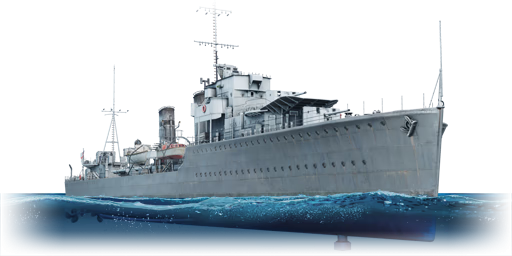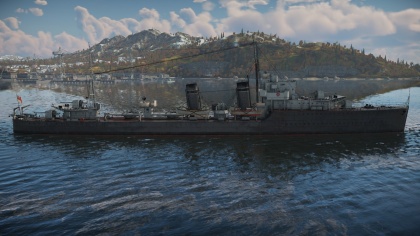Difference between revisions of "HMS Grafton"
Inceptor57 (talk | contribs) (→History) |
Inceptor57 (talk | contribs) m (→History) |
||
| Line 54: | Line 54: | ||
== History == | == History == | ||
<!--''Describe the history of the creation and combat usage of the ship in more detail than in the introduction. If the historical reference turns out to be too big, take it to a separate article, taking a link to an article about the vehicle and adding a block "/ History" (example: <nowiki>https://wiki.warthunder.com/(Vehicle-name)/History</nowiki>) and add a link to it here using the <code>main</code> template. Be sure to reference text and sources by using <code><nowiki><ref></nowiki></code>, as well as adding them at the end of the article.''--> | <!--''Describe the history of the creation and combat usage of the ship in more detail than in the introduction. If the historical reference turns out to be too big, take it to a separate article, taking a link to an article about the vehicle and adding a block "/ History" (example: <nowiki>https://wiki.warthunder.com/(Vehicle-name)/History</nowiki>) and add a link to it here using the <code>main</code> template. Be sure to reference text and sources by using <code><nowiki><ref></nowiki></code>, as well as adding them at the end of the article.''--> | ||
| − | + | HMS Grafton was laid down in August 1934 as the fifth ship of nine G-class destroyers being built by British dockyards in the interwar years. Almost two years later, in March 1936, the ship was completed and joined the ranks of the Royal Navy. | |
HMS Grafton spent her early service days as part of the 1st Destroyer Flotilla operating in the Mediterranean. During the Spanish Civil War, HMS Grafton assisted in enforcing the non-intervention policy alongside warships of other nations. | HMS Grafton spent her early service days as part of the 1st Destroyer Flotilla operating in the Mediterranean. During the Spanish Civil War, HMS Grafton assisted in enforcing the non-intervention policy alongside warships of other nations. | ||
Revision as of 04:18, 9 March 2019
Contents
Description
The G-class, HMS Grafton (H89), 1936 is a rank I British destroyer
with a battle rating of 3.7 (AB/RB/SB). It was introduced in Update 1.83 "Masters of the Sea" as part of the British fleet closed beta test.
General info
Survivability and armour
Talk about the vehicle’s armor. Note the most well-defended and most vulnerable zones, e.g. the ammo magazine. Evaluate the composition of components and assemblies responsible for movement and maneuverability. Evaluate the survivability of the primary and secondary armament separately. Don't forget to mention the size of the crew, which plays an important role in fleet mechanics. Tips for preserving survivability should be saved for the “Use in battle” section.
If necessary, use a graphic template to show the most well-protected or most vulnerable points in the armor.
Mobility
Write about the ship’s mobility. Evaluate its power and maneuverability, rudder rerouting speed, stopping speed at full tilt, with its maximum forward speed and reverse speed.
Armament
Primary armament
Provide information about the characteristics of the primary armament. Evaluate their efficacy in battle based on their reload speed, ballistics and the capacity of their shells. Add a link to the main article about the weapon: {{main|Weapon name}}.
Broadly describe the ammunition available for the primary armament, and provide recommendations on how to use it and which ammunition to choose.
Secondary armament
Some ships are fitted with weapons of various calibers. Secondary armament is defined by the weapon chosen with the control Select secondary weapon. Evaluate the secondary armament and give advice on how to use them. Describe the ammunition available for the secondary armament. Provide recommendations on how to use them and which ammunition to choose. Remember that anti-air armament, even heavy caliber weapons, belong in the next section.
If there is no secondary armament, remove this section.
Anti-aircraft armament
An important part of the ship’s armament responsible for air raid defense. Anti-aircraft armament is defined by the weapon chosen with the control Select anti-aircraft weapons. Talk about the ship’s anti-air cannons and machine guns, the number of guns and their positions, their effective range, and about their overall effectiveness – including against surface targets.
If there is no anti-aircraft artillery, remove this section.
Torpedo armament
Many ships are armed with torpedo launchers, and for some vessels such as boats, torpedoes are an extremely important means of defeating an opponent. Evaluate the position of the torpedo launchers, discuss the ammunition available, firing specifics such as dead zones, features of the torpedoes themselves, etc.
If there is no torpedo armament, remove this section.
Special armament
Depth charges, mines, rocket launchers and missiles are also effective in skilled hands and can be an unexpected surprise for an opponent. Evaluate the ammunition of this type of armament and rate its performance in combat.
Usage in battles
Describe the technique of using this ship, the characteristics of her use in a team and tips on strategy. Abstain from writing an entire guide – don’t get try to provide a single point of view, but give the reader food for thought. Talk about the most dangerous opponents for this vehicle and provide recommendations on fighting them. If necessary, note the specifics of playing with this vehicle in various modes (AB, RB, SB).
Pros and cons
Summarize and briefly evaluate the vehicle in terms of its characteristics and combat effectiveness. Mark its pros and cons in the bulleted list. Try not to use more than 6 points for each of the characteristics. Avoid using categorical definitions such as "bad", "good" and the like - they have a substitution in the form of softer "inadequate", "effective".
Pros:
Cons:
History
HMS Grafton was laid down in August 1934 as the fifth ship of nine G-class destroyers being built by British dockyards in the interwar years. Almost two years later, in March 1936, the ship was completed and joined the ranks of the Royal Navy.
HMS Grafton spent her early service days as part of the 1st Destroyer Flotilla operating in the Mediterranean. During the Spanish Civil War, HMS Grafton assisted in enforcing the non-intervention policy alongside warships of other nations.
During the outbreak of WW2 in September 1939, HMS Grafton was undergoing refits at Malta, being called back to British waters in the following October. In early 1940, Grafton underwent minor overhaul work before being assigned to escort convoys headed for Norway.
At the same time, the war situation in France was looking desperate with the start of the Siege of Calais. Operation Dynamo, the allied effort of evacuating cut-off troops from Dunkirk, commenced shortly after. HMS Grafton answered the call and assisted with evacuating troops from the 27th, May 1940.
Two days later however, HMS Grafton spotted survivors of the previously sunk destroyer HMS Wakeful and stopped to commence rescue efforts. Stationary, Grafton presented herself as easy prey for any attacker. Soon enough, she found herself in the crosshairs of the German submarine U-62.
Although severely damaged by the torpedo attack, HMS Grafton stayed afloat long enough for her survivors to be rescued by the destroyer HMS Ivanhoe. Realizing the extent of her damage, the decision was made to scuttle HMS Grafton by gunfire from Ivanhoe. After the shelling, HMS Grafton quickly sank to the bottom, marking the end of her service life and contribution to WW2.
- From Devblog
Media
An excellent addition to the article will be video guides, as well as screenshots from the game and photos.
See also
Links to the articles on the War Thunder Wiki that you think will be useful for the reader, for example:
- reference to the series of the ship;
- links to approximate analogues of other nations and research trees.
External links
| Britain destroyers | |
|---|---|
| Town-class | HMS Churchill · HMS Montgomery |
| V-class | HMS Valhalla · HMS Vega · HMS Verdun |
| G-class | HMS Grafton · ORP Garland |
| Hunt-class | HMS Calpe · HMS Brissenden |
| Tribal-class | HMCS Haida · HMS Eskimo · HMS Mohawk |
| J-class | HMS Jervis |
| K-class | HMS Kelvin |
| N-class | HMAS Nepal |
| Battle-class | HMS Armada · HMS Cadiz · HMAS Tobruk |
| Daring-class | HMS Daring · HMS Diamond · HMS Diana |





